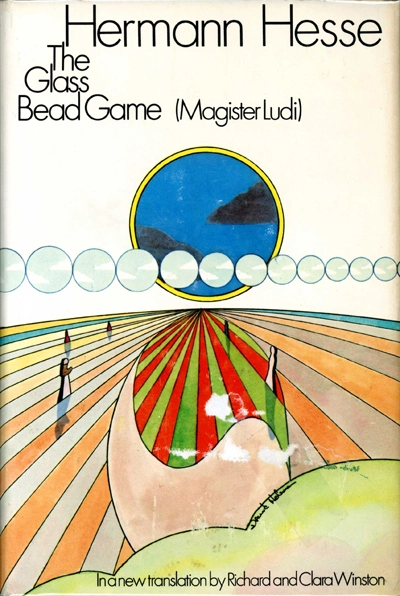1969 English language edition
One in a series of posts dedicated to the author’s favorite semiopunk sci-fi.
Set in a post-catastrophic, ambiguously utopian twenty-fifth century (after “the shocks of the last great epoch of wars”), Hermann Hesse’s 1943 novel The Glass Bead Game was his last full-length novel. It was begun in 1932 — at a time when Hesse was observing the rise of Nazism in his native Germany with great concern. The novel imagines an intentional community, Castalia, the members of which are dedicated to studying all Eastern and Western arts and scholarship… in order to dialectically synthesize via a complex game.
The glasperlenspiel is a mode or means of playing with the totality of a culture’s insights, ideas, and values — each of which is symbolized by a uniquely colored glass bead. The beads are organized, by means of stringing them on an abacus-like framework, into patterns which — to the game’s players — are tremendously significant. The goal of each individual game is to compete in developing “themes” much like a piece of classical music does. The game’s players are intellectual-artistic supermen, if you will; an elite few who have been selected and trained for this purpose from an early age.
The novel purports to be the work of a narrator who has assembled manuscripts concerning Josef Knecht, who becomes the Master of the Glass Bead Game, and whose life is narrated in the novel. The course of Knecht’s life is described as “a circle, or an ellipse or spiral or whatever, but certainly not a straight line” — which suggests to this spiral/ellipse-sensitive reader, at least, that it would perhaps also be useful to our analysis if we thought of The Glass Bead Game not only as a crucial early example of semiopunk sf but as a Jarry-esque ’pataphysical novel.
What is the glasperlenspiel? We don’t know, exactly… nor can we know, since like all utopian (anti-anti-utopian, really) literature, The Glass Bead Game posits a novum that is unrepresentable, at least in certain critical respects, to those of us still in a pre-utopian state. Here’s what we can know: The glasperlenspiel is an epistemological exercise that draws its players “into the center, the mystery and innermost heart of the world, into primal knowledge.”
The glasperlenspiel explores what things mean… and how they mean what they mean. How things mean what they mean turns out to have something to do with elegant, thrilling patterns. We’re told the game is a “dynamic phenomenon” comprehended in “an image of rhythmic processes,” a difficult and rewarding exercise in deconstruction and decoding, pattern recognition, and patterning. The result might be thought of as a “G[lasperlenspiel]-schema.”
Players of the glasperlenspiel must be deeply well-versed in all the arts and sciences, as well in religious and philosophical concepts, in order to comprehend and communicate in its “sacred and divine language.” Though the players must be deeply familiar with all sorts of scholarship, scholars with a too-narrow purview need not apply.
In a 1944 letter to a friend who’d asked about the novel, Hesse says the glasperlenspiel is “a language, a complete system; it can be played in every manner conceivable, by one person improvising, by several people in a structured way, competitively and also hieratically.” By “hieratically,” he appears to mean: In the manner of one interpreting an esoteric sacred text. There is a neo-Platonic subtext here; a sense that the philosopher’s mission is to surface and dimensionalize his culture’s latent, tacit, unspoken norms and forms.
All of which sounds way too earnest for a game, right? Which is why it’s important to note that, for Hesse’s characters, playing the glasperlenspiel transcends the earnest/fun dichotomy. The game’s players understand that while earnestness may be the opposite of light-heartedness, seriousness is not. It’s been pointed out that Schiller’s 1795 treatise On the Aesthetic Education of Mankind is surely a key literary intertext for Hesse’s novel. Here, Schiller articulates a high-lowbrow ideal according to which “the most frivolous theme must be so treated that it leaves us ready to proceed directly from it to some matter of the utmost import,” and conversely, “the most serious material must be so treated that we remain capable of exchanging it forthwith for the lightest play.”
Hesse, who’d predicted that the Weimar Republic would collapse in the face of Nazism, had in the early 1930s started to conceive of a utopian alternative: Castalia, with its monastic order of highly skilled educators whose influence on a future society will be a civilizing one. In fact, the book is dedicated to the Morgenlandfahrer, a reference to Hesse’s Die Morgenlandfahrt (Journey to the East, 1932), which depicts a league of like-minded travelers in time and space who pursue their common ideals in a quest — though troubled by self-doubt, lack of courage, and worldly distractions.
Knecht is confronted with similar difficulties. He comes to realize that the glasperlenspiel can lead to empty virtuosity, to the egotistic satisfaction of vanity, to ambitiousness, and to the acquisition and misuse of power. “Truth is lived, not taught,” he comes to understand. The abstract dimension in which the glasperlenspiel players spend their waking hours is less valuable, in the end, than — for all its chaos, misery, and stupidity — the real world from which they’d worked to free themselves. Castilia is an ambiguous utopia.
Might it be possible to renew and redeem the glasperlenspiel, by removing it from its austere context? There’s a hint, at the story’s end, that a wayward, strong-willed, nature-loving young pupil, son of an old friend of Knecht’s who’d long argued that Castalia is an ivory tower with no impact on the real world, will (literally and figuratively) assume Knecht’s mantle.


